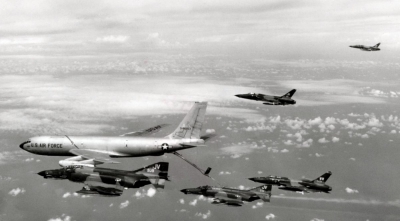The Easter Offensive, also known as the 1972 springsummer offensive (Vietnamese: Chin dch XunH 1972) by North Vietnam, or the red fiery summer (Ma h la) as romanticized in South Vietnamese literature, was a military campaign conducted by the People's Army of Vietnam (PAVN, the regular army of North Vietnam) against the Army of the Republic of Vietnam (ARVN, the regular army of South Vietnam) and the United States military between 30 March and 22 October 1972, during the Vietnam War. This conventional invasion (the largest invasion since 300,000 Chinese troops had crossed the Yalu River into North Korea during the Korean War) was a radical departure from previous North Vietnamese offensives. The offensive was designed to achieve a decisive victory, which even if it did not lead to the collapse of South Vietnam, would greatly improve the North's negotiating position at the Paris Peace Accords.
The U.S. high command had been expecting an attack in 1972 but the size and ferocity of the assault caught the defenders off balance, because the attackers struck on three fronts simultaneously, with the bulk of the North Vietnamese army. This first attempt by the Democratic Republic of Vietnam (North Vietnam) to invade the south since the Tet Offensive of 1968, became characterized by conventional infantryarmor assaults backed by heavy artillery, with both sides fielding the latest in technological advances in weapons systems.
In the I Corps Tactical Zone, North Vietnamese forces overran South Vietnamese defensive positions in a month-long battle and captured Qung Tr city, before moving south in an attempt to seize Hu. The PAVN similarly eliminated frontier defense forces in the II Corps Tactical Zone and advanced towards the provincial capital of Kon Tum, threatening to open a way to the sea, which would have split South Vietnam in two. Northeast of Saigon, in the III Corps Tactical Zone, PAVN forces overran Lc Ninh and advanced to assault the capital of Bnh Long Province at An Lc.
The campaign can be divided into three phases: April was a month of PAVN advances; May became a period of equilibrium; in June and July the South Vietnamese forces counter-attacked, culminating in the recapture of Qung Tr City in September. On all three fronts, initial North Vietnamese successes were hampered by high casualties, inept tactics and the increasing application of U.S. and South Vietnamese air power. One result of the offensive was the launching of Operation Linebacker, the first sustained bombing of North Vietnam by the U.S. since November 1968. Although South Vietnamese forces withstood their greatest trial thus far in the conflict, the North Vietnamese accomplished two important goals: they had gained valuable territory within South Vietnam from which to launch future offensives and they had obtained a better bargaining position at the peace negotiations being conducted in Paris.
Operation Linebacker was the codename of a U.S. Seventh Air Force and U.S. Navy Task Force 77 air interdiction campaign conducted against North Vietnam from 9 May to 23 October 1972, during the Vietnam War.
Its purpose was to halt or slow the transportation of supplies and materials for the Nguyen Hue Offensive (known in the West as the Easter Offensive), an invasion of the South Vietnam by forces of the People's Army of Vietnam (PAVN) that had been launched on 30 March. Linebacker was the first continuous bombing effort conducted against North Vietnam since the end of Operation Rolling Thunder in November 1968.

1972Oct, 23
Operation Linebacker, a US bombing campaign against North Vietnam in response to its Easter Offensive, ends after five months.
Choose Another Date
Events on 1972
- 21Feb
Sino-American relations
United States President Richard Nixon visits the People's Republic of China to normalize Sino-American relations. - 8May
Richard Nixon
Vietnam War: U.S. President Richard Nixon announces his order to place mines in major North Vietnamese ports in order to stem the flow of weapons and other goods to that nation. - 22May
Sri Lanka
Ceylon adopts a new constitution, becoming a Republic, changes its name to Sri Lanka, and joins the Commonwealth of Nations. - 23Jun
Central Intelligence Agency
Watergate scandal: U.S. President Richard M. Nixon and White House Chief of Staff H. R. Haldeman are taped talking about using the Central Intelligence Agency to obstruct the Federal Bureau of Investigation's investigation into the Watergate break-ins. - 1Sep
Bobby Fischer
In Reykjavík, Iceland, American Bobby Fischer beats Russian Boris Spassky to become the world chess champion.

 English
English  español
español  français
français  português
português  русский
русский  العربية
العربية  简体中文
简体中文 